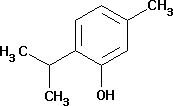Thymol Chemical
Thymol Chemical Specification
- Usage
- Lab Chemicals
- Storage Instructions
- Dry Place
- Grade
- Industrial
- Type
- Industrial Lab Chemicals
- Application
- Lab Chemicals
- Purity(%)
- 99.99
About Thymol Chemical
Thymol ChemicalLC5469 Thymol cryst., suitable for use as excipient exp Ph Eur,BP,NF Order number Packaging Quantity Price AC32469 Glass bottle 1 kg Inquire AC32469 Steel drum 25 kg Inquire Product information Grade Ph Eur,BP,NF Synonyms 5-Methyl-2-(1-methylethyl)phenol, 1-Methyl-3-hydroxy-4-isopropylbenzene Hill Formula C10H14O HS Code 2907 19 90 EC number 201-944-8 Molar mass 150.22g/mol EC index number 604-032-00-1 CAS number 89-83-8 Chemical and physical data Ignition temperature 285oC Solubility 0.98g/l (25oC) Melting point 49-51oC Molar mass 150.22g/mol Density 0.97g/cm3 (20oC) Bulk density 600kg/m3 pH value 5-7 (0.8g/l, H2O, 20oC) Boiling point 233oC(1013hPa) Vapor pressure 2.5hPa (50oC) Flash point 104oC Viscosity kinematic 4.3mm2/s (50oC) Safety information according to GHS Hazard Statement(s) H302: Harmful if swallowed.H314: Causes severe skin burns and eye damage.H411: Toxic to aquatic life with long lasting effects. Precautionary Statement(s) P273: Avoid release to the environment.P301 + P330 + P331: IF SWALLOWED: rinse mouth. Do NOT induce vomiting.P305 + P351 + P338: IF IN EYES: Rinse cautiously with water for several minutes. Remove contact lenses, if present and easy to do. Continue rinsing. Signal Word Danger Hazard Pictogram(s) RTECS XP2275000 Storage class 8 A Combustible substances, corrosive WGK WGK 2 water endangering Disposal 3Relatively unreactive organic reagents should be collected in container A. If halogenated, they should be collected in container B. For solid residues use container C. Safety information R Phrase R 22-34-51/53Harmful if swallowed.Causes burns.Toxic to aquatic organisms, may cause long-term adverse effects in the aquatic environment. S Phrase S 26-28-36/37/39-45-61In case of contact with eyes, rinse immediately with plenty of water and seek medical advice.After contact with skin, wash immediately with plenty of soap and water.Wear suitable protective clothing, gloves and eye/face protection.In case of accident or if you feel unwell, seek medical advice immediately (show the label where possible).Avoid release to the environment. Refer to special instructions/ Safety data sheets. Categories of danger harmful, corrosive, dangerous for the environment Hazard Symbol Corrosive Dangerous for the environment Transport information Declaration (transport by sea) IMDG-Code UN 2430 ALKYLPHENOLS, SOLID, N.O.S.(5-METHYL-2-(1-METHYLETHYL)PHENOL), 8, III Declaration (transport by air) IATA-DGR UN 2430 ALKYLPHENOLS, SOLID, N.O.S.(5-METHYL-2-(1-METHYLETHYL)PHENOL), 8, III Toxicological data LD 50 oral LD50 rat 980 mg/kg LD 50 dermal LD50 rat > 2000 mg/kg Specifications Assay(bromatometric) 99.0 - 101.0% Purity(GC) 99.0 - 100.0% Identity - IR-spectrum passes test - Melting range passes test Appearance colourless or white to almost white crystals Appearance of solution(100 g/l; NaOH (85g/l)) clear and not more intense in colour than colour reference solution R6; 30 NTU Acidic substances passes test Melting range - lower value 48oC - upper value 51oC Related substances (GC) - largest single impurity 0.3% - Sum of all impurities 1.0% Non volatile matter 0.05% Residual solvents (Ph.Eur./USP/ICH) class 3(Heptane) 0.03% Other residual solvents (Ph.Eur./USP/ICH) excluded by the manufacturing processFAQs of Thymol Chemical:
Q: What is the purity of Thymol Chemical?
A: Thymol Chemical has a purity of 99.99%.Q: What is the recommended storage condition for Thymol Chemical?
A: Thymol Chemical should be stored in a dry place.Q: What grade is Thymol Chemical?
A: Thymol Chemical is of industrial grade.Q: What is the application of Thymol Chemical?
A: Thymol Chemical is used as a lab chemical.Q: What type of chemical is Thymol Chemical classified as?
A: Thymol Chemical is classified as an industrial lab chemical.

Price:
- 50
- 100
- 200
- 250
- 500
- 1000+
More Products in Laboratory Chemicals Category
DIETHYL PHTHALATE (for synthesis)
Minimum Order Quantity : 25 gm, Kilograms
Type : University Lab Chemicals
Purity(%) : 99%
Grade : AR
Storage Instructions : Store in tightly closed container, in cool and dry place
Application : For synthesis, research, and laboratory use
BATHOPHENANTHROLINE AR
Minimum Order Quantity : 1 Gram
Type : Other, Analytical Reagent
Purity(%) : 99%
Grade : AR
Storage Instructions : Store in cool, dry place, tightly closed container
Application : Laboratory reagent, spectrophotometric determination of iron
2 -Thiouracil
Minimum Order Quantity : 500 Milliliters
Type : Industrial Lab Chemicals
Purity(%) : 99.99
Grade : Industrial
Storage Instructions : Dry Place
Application : Lab Chemicals
Tributyltin Acetate
Type : Industrial Lab Chemicals
Purity(%) : 99.99
Grade : Industrial
Storage Instructions : Dry Place
Application : Lab Chemicals
"Only deals in retail accepting orders upto 500ml only".
 |
ALPHA CHEMIKA
All Rights Reserved.(Terms of Use) Developed and Managed by Infocom Network Private Limited. |
 English
English Spanish
Spanish French
French German
German Italian
Italian Chinese (Simplified)
Chinese (Simplified) Japanese
Japanese Korean
Korean Arabic
Arabic Portuguese
Portuguese


 Send Inquiry
Send Inquiry






